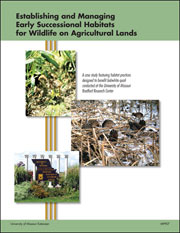Foreword
A diversity of early successional plant communities within the agricultural landscape provides food and cover for a variety of wildlife species, including bobwhite quail, grassland birds and cottontail rabbits. However, this type of habitat is in short supply on many farms in Missouri. This publication describes the process used to create and manage early successional vegetation at the University of Missouri Bradford Research Center (MU BREC), located near Columbia. The framework for making habitat management decisions is described, and the process used for planning and implementing management practices is highlighted. This report serves as a case study showcasing wildlife habitat practices landowners can implement that benefit bobwhite quail and a variety of other wildlife and that can be designed to complement ongoing farm management, agronomic and economic goals and objectives.
Tasks performed to accomplish case study objectives
- Established edge-feathering and field border management practices around crop fields for improved wildlife habitat and increased corn and soybean yields at edges of the field.
- Compared combinations of native stiff-stemmed grasses within a grass waterway diversion channel for potential conservation benefits.
- Demonstrated management practices that control invasive species such as reed carnarygrass and sericea lespedeza.
- Established native warm-season grasses and forbs that can be used as an alternative to nonnative cool-season grasses such as tall fescue.
- Conducted management practices, including prescribed burning and disking, in stands of native warm-season grasses for improved wildlife habitat.
- Established native shrubs for developing covey headquarters and escape cover habitat.
- Conducted educational programs, including field days and workshops, to demonstrate management practices for the above objectives.
Photo credits
Donna Brunet, Robert A. Pierce II, Tim Reinbott, Ray Wright and the Missouri Department of Conservation
Production
Victoria Knapp, Editor, MU Extension and Agricultural Information
